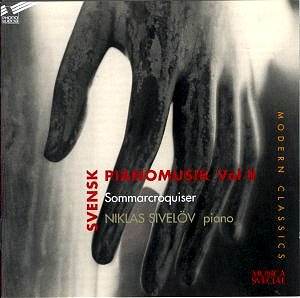With the exception of Rangström the names of these
composers are all but a closed book outside well informed Swedish circles.
Much the same can be said of the first collection on PSCD715. There
the quasi-exception was Yngve Sköld - hardly a household name.
You have to hand it to the Swedes; they do not lack courage, steady
resolve and adventurous artistic spirit. They and colleagues in Denmark
remain an example to other nations in this respect.
Seymer, who made his living from music journalism,
wrote a modest number of pieces. His Summer Sketches are rather
Grieg-like. Certainly they have that difficult to define Scandinavian
air of innocence and yearning about them. This is Macdowell yet tougher;
Børresen yet more emphatically Nordic; John Ireland yet more
direct. Milveden has also produced sparingly, his concentration
being on scholarship of Gregorian and medieval music. The Sonatina is
a spicy brew; more 'modern' than the Seymer (whose roots lie with Mendelssohn
and Schumann). There are discords and rhythmic devices that for me recall
Lennox Berkeley rather than the models (Hindemith and Nielsen) suggested
by distinguished note-writer Lennart Hedwall. Morales' Spanish
heritage is embraced rather than denied in the passionate Two Fantasies
which are, in the case of the first, partly Goyescas and partly
Ireland's Amberley Wild Brooks. The second is another of those
decisive, plungingly tempestuous pieces derived from the great examples
of Liszt (the Sonata) and Rachmaninov (the two sets of Etudes-Tableaux).
Rangström, writing within five years before his death, writes
an almost conventional set of rural sketches setting out the ways of
the peripatetic fiddlers: romantic, inconstant, rootless and with that
tantalising hint of danger and the sinister (try the Allegro furioso
tr. 12). The sequence ends inventively, without self-pity, in moonlight,
with the fiddler alone.
Mankell was taught by Liszt pupil, Hilda Thegerström
and wrote a piano concerto (1917), three piano sonatas (1908-1918) and
six Fantasy Sonatas (1926-29). Going by his Two Nocturnes his music
stands between the 'tropical' impressionism of Cyril Scott, the modest
woodland sentiment of Macdowell and the lichen-trailing ambiguities
of Frank Bridge. The Bridge connection is strongest in the tintinnabulation
of the second nocturne (tr.14). Håkanason's Variations
are rather unsurprising and classically conventional. The folksong is,
unnervingly for British ears, rather like God Save The Queen
leaving the impression of some piano-duelling piece by Ries or Kalkbrenner,
Henselt or Liszt. This is not the most attractive work here but one
misfire amongst six is not bad ... and who knows ... you may find more
than I did in this piece.
The liner notes (Swedish and English) are much enhanced
by good portraits of the composers.
Sivelöv, who makes a bright-eyed and subtle champion
for this music, is strongly recorded. Another feather in the Phono-Sueciae
cap.
Rob Barnett
